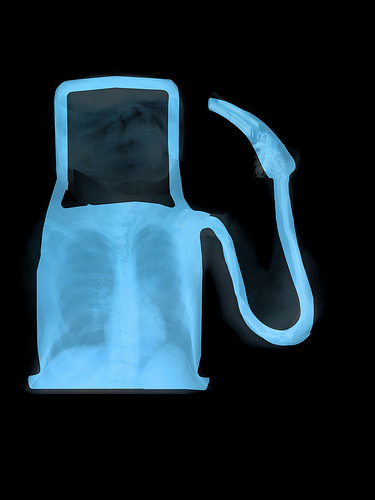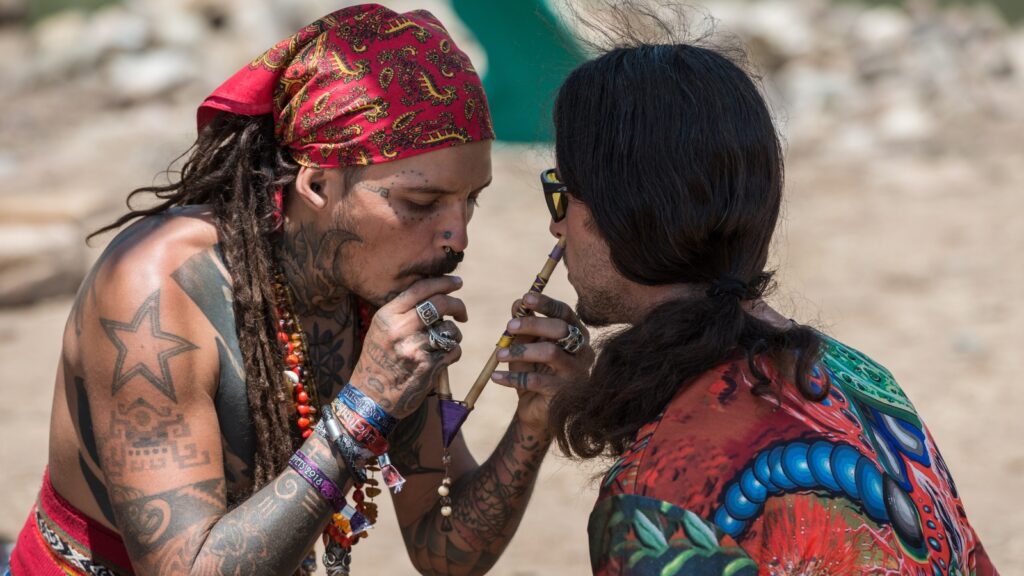Occupy Wall Street and the related movements around the globe may represent far more than an ideological struggle over intellectually abstract propositions. The surge of social activity might just be an adaptive and organic response to environmental pressures. Famously, Occupy is ‘leaderless’ and its trans-national and ideologically inclusive character seems to defy convention by giving voice to a full-spectrum of political positions such as conservative, liberal, communist, anarchist and so forth. While some participants cry for reform and others for revolution, Occupy performs what appears to be a boundaryless debate over the very nature of society and civilization itself.
Unsurprisingly, the propaganda matrix (see Manufacturing Consent) has played their part as apologist for the status quo, often overemphasizing the leaderless nature of Occupy as a political weakness. This is, no doubt, a limp effort to downplay the movement’s swelling international popularity. But what can we make of this pan-ideological awakening? What are the roots this organic uprising? Going beyond the obvious supposition that it is emerging simply as an expression of conflict between the ‘Haves’ and ‘Have-nots,’ two articles recently published in ‘Science Daily’ may provide us with the basis for an interesting neurological perspective as, evidently, the human nervous system is wired in such a manner that it promotes “moral behavior” and “cooperation.”
The first article, a July piece from ‘Science Daily’ entitled “Brain Co-opts The Body to Promote Moral Behavior,” considered the work of Mary Helen Immordino-Yang of the USC Brain and Creativity Institute. According to Yang, “The human brain may simulate physical sensations to prompt introspection, capitalizing on moments of high emotion to promote moral behavior.” The article explains, “… individuals who were told stories designed to evoke compassion and admiration for virtue sometimes reported that they felt a physical sensation in response. These psycho-physical ‘pangs’ of emotion are very real — they're detectable with brain scans — and may be evidence that pro-social behavior is part of human survival.”
The article continues by quoting Yang:
"These emotions are foundational for morality and social learning. They have the power to change the course of your very life… Our very biology is a social one. For centuries poets have described so-called gut feelings during social emotions. Now we are uncovering the biological evidence."
Think of all the grassroots media that emerged from Occupy; the speeches given by Zizek, Dr. West, and Reverend Billy in New York City, the images of darkly clad riot police descending upon youths in Oakland and blasting their skulls with rubbery projectiles. And think of what created Occupy: the reports, stories, photos, documents, and memes that have been building and building. This new century is witness to an information explosion, a rise in citizen reporting, and a plethora of journalistic documentaries aimed at exposing corruption, exploitation, hypocrisy, abuse, rape, and genocide throughout the world. Though, one could’ve probably just talked to their foreclosed neighbor, or futureless child, or disabled parent, or scared lover, to hear one good reason or another to start demonstrating.
The second ScienceDaily article is a piece called “It Takes Two: Brains Come Wired For Cooperation,” which immediately rocks the foundations of the socioeconomic myth of incentive and competition. "What we learned is that when it comes to the brain and cooperation, the whole is definitely greater than the sum of its parts," said Fortune, of the Department of Psychological and Brain Sciences at the Krieger School of Arts and Sciences. "We found that the brain of each individual participant prefers the combined activity over his or her own part." Perhaps we are one another’s incentive. And by examining a species of, “chubby-breasted rust-and-gray birds, who don't fly so much as hop and flit through the area's bamboo thickets,” these researchers found that, “It looked like the brains of wrens are wired to cooperate."
The article continues quoting the researchers in order to substantiate a link to human behavior:
"Brains among vertebrate animals — frogs, cats, fish, bears and even humans — are more similar than most people realize," Fortune said. "The neurotransmitter systems that control brain activity at the molecular level are nearly identical among all vertebrates and the layout of the brain structures is the same. Thus, the kinds of phenomena that we have described in these wrens is very relevant to the brains of most, if not all, vertebrate species, including us humans."
So not only are we neurologically designed to cooperate (brains don’t like to work on their own: solitary confinement is a punishment) we are also designed to respond in moral-emotive ways. But why doesn’t this seem to work in the nosebleed offices of the corporate elite? Why do financial terrorists like the IMF seem eerily immune to these finds?
A 2005 article in the Wall Street Journal entitled, “Lessons from the Brain Damaged Investor” may shed light on what’s going at the level of the brainstem. According to the article:
“People with certain kinds of brain damage may make better investment decisions. That is the conclusion of a new study offering some compelling evidence that mixing emotion with investing can lead to bad outcomes.
By linking brain science to investment behavior, researchers concluded that people with an impaired ability to experience emotions could actually make better financial decisions than other people under certain circumstances…. The 15 brain-damaged participants that were the focus of the study had normal IQs, and the areas of their brains responsible for logic and cognitive reasoning were intact. But they had lesions in the region of the brain that controls emotions, which inhibited their ability to experience basic feelings such as fear or anxiety. The lesions were due to a range of causes, including stroke and disease, but they impaired the participants' emotional functioning in a similar manner.
The study suggests the participants' lack of emotional responsiveness actually gave them an advantage when they played a simple investment game. The emotionally impaired players were more willing to take gambles that had high payoffs because they lacked fear. Players with undamaged brain wiring, however, were more cautious and reactive during the game, and wound up with less money at the end.
Some neuroscientists believe that good investors may be exceptionally skilled at suppressing emotional reactions, ‘It's possible that people who are high-risk takers or good investors may have what you call a functional psychopathy,’ says Antoine Bechara, an associate professor of neurology at the University of Iowa, and a co-author of the study. ‘They don't react emotionally to things. Good investors can learn to control their emotions in certain ways to become like those people.'”
In true-to-form Murdochian underling fashion, the publication fails to meaningfully extrapolate the follicle-tearing irony that in the earthly definition of civilization, as outlined by its market operations, invalids who can identify child-drowning with watching paint dry are the most valuable, contributing members of society. But you don’t need to read something as sophisticated as WSJ to begin to suspect that this show’s run by the cream of the non compos mentis crop. All you have to do is consider the arms race of the last century, or the attempts to construct the Keystone XL pipeline less than a year after British Petroleum lubricated the entire Gulf of Mexico, or the wage slaves who have been tramped to death by foaming superstore shoppers (a phenomenon not isolated to Wal-Marts in the US, but found in Saudi Ikea’s as well). In short, society and civilization have become a series of potentially terricidal risks, which is a product of the current socioeconomic religion that is managed by dysfunctional HAL 9000s in grotesque three-piece megasuits. Therefore, what we could be witnessing through Occupy may be an ethically motivated bio-psycho-social response to a systemic-process that is being perceived as a threat to the collective organism. It is an international demonstration of repulsion.
Organisms naturally want to live and they will do so in cooperative and moral ways, unless they are brain-damaged. Thus, when environmental factors that are toxic enter into an organism’s sphere of circumstance and threaten its very existence, the organism responds. What was probably overlooked by the people who have been cheerfully profiting off of planetary and social devastation is the natural response mechanism of its denizens. And the landscapes of distraction that typifies the cosmopolitan today may not be powerful or convincing enough when the collective organism begins to feel its very life is in danger. Indeed no matter how good a film, concert, or lap dance might be, no one’s going to stick around for the climax when bile-colored chlorine gas is wafting in from the bathrooms, the second-flood is collapsing from a structural fire, and legions start popping up under our fingernails. Even the ancient method of divide and conquer via ideological, political, philosophical, religious, sexist, or even classist dichotomies may prove ineffective if everyone is drinking form the same hydrofracked stream or watching the neighborhood kids build and eat radioactive snowmen. Natural programming is often stronger than cultural programming. This is why people don’t die from perforation of the bowl while watching television: even the most slacked change rooms and chairs to expel lunch. One might ask, “Can an organism be conditioned for death?” Soft-killing seems to work (tobacco smoke, sedentary lifestyle, etc); but an animal is unhealthy in the classic sense when it actively seeks self-destruction: as life no doubt desires life; is purposefully life. Von Trier’s self-disemboweling Fox sums up this point, “Chaos reigns.” Though some of the most psychologically flexible may disagree (e.g. suicide bombers), they will no doubt look to eat, shit, and breathe sometime after proposing the alternative.
So given that we more or less want to live, and we are wired to want to do so both cooperatively and morally, lets compound the above articles with the wireless internet and social media. If the human being evolves beside media (everything from the cave art and the word to the billboard and the tweet) and technology (from the hammer to the cellphone) the internet is without contest the champion psycho-technological development in our species’ history.
The Internet gives thought a kind of pseudo-physicality. It is the mind crystalized and compressed into digital electricity and spread amongst us like an invisible cloud we can tap into at any time. On a second-by-second basis we are in touch with all the world’s corruption, poverty, triumph, oppression, pain, misery, wonder, and glory. And today, we no longer even need to be online to be online. The web seems to just live in the background of our consciousness as its taken on the role of universal referent and the primary mode experience between physical encounters. Considering this, I’ve flirted with an idea called “telewaking” for some time now.
Take Lacan’s mirror stage (where an infant moves from being without self and focused solely on the breast, to the emergence of self via interaction with mirrors, awareness of personal volition via bodily control, and awakening to its role as the prime focus of maternal adoration), along with mirror-neurons (an animal simulates the feelings and imitates the behavior of what another animal displays), Francis Heylighen’s update of McLuhan’s “global village” with “the global superorganism” (necessarily translating to an ever more public and participatory life), and Amber Case’s cyborg anthropology–mix it all together and you realize we are on the threshold of a new psychological calamity. We are living an evermore-public and participatory lifestyle. We are sharing more and more of ourselves, our collective suffering, our collective triumphs, our collective struggles, and thus feeling the species more as a holistic system composed of universal semi-selves. This new bio-psycho-socio-spiritual eruption I refer to as the Mirror-Mirror Stage. This is a play on the feedback loop between physical happenings and the Internet, Turkle’s evaluation of the computer as a reflective psychological object, and the fantasticalness of Snow White “Mirror-mirror in my pocket, where’s the cheapest café in town?”
Thus, rather than the emphasis and crisis being one of "self-ness" the crisis is one of "us-ness." It is like a toddler's awakening to self–to ego, will, volition, intent, consequence, modification, responsibility, choice, maturity, and so on, only on a cross-cultural, transnational scale. We have matured from a single self gazing into a window pane reflection into an overgrown hive awaking to the presence of, and our relationship to, the others within a planet-sized funhouse.
What is knocking at the door of awakened apprehension is a species-wide biopsychosocial mutation of a spiritual nature. What we are undergoing through social media is the refurbishment of the ego from quasi-isolates in space-time to becoming the very cosmic landscape of which one speaks of. As Ken Wilber recently said of eros:
Is it [eros] egocentric–Are you identifying merely with your own self, your own limited awareness? Or is it ethnocentric and you are identified with a particular group, cause, or set of values, excluding all other groups and values? If this is the case you will likely have a fundamentalistic identity with a particular cause whether that cause is fundamental religiousness: Christian, or Muslim, or Hindu. Or favorite movement: Marxist, feministic, patriotic. Or favorite philosophy: scientistic, rationalistic, or reductionist. Or do your chosen values transcend all limited values and identify instead with a post-conventional sympathy with all humanity, regardless of race, color, sex or creed? In this world-centric orientation you feel a fundamental unity with all of human kind. Racist, or sexist, or ethnocentric remarks actually embarrasses you as something as essentially alien to your level of unity…The point is that you no longer hold merely conventional or ethnocentric values, but have expanded your identity to world-centric levels of love and unity. Or have you gone further yet and find your identity transcending the merely human to all of manifestation itself? To all sentient beings and the ground of all being. Here you no longer look at a mountain. You are the mountain. You feel fundamentally one with all of experience. All of manifest and unmanifest existence, a truly cosmos-centric unity…driven top to bottom by eros, by love, by a drive of evolving unity at all levels. And one’s very sense of being expands to a oneness with the All itself, with every aspect of reality, inside and out, individual and collective, being and becoming. In the deepest part of your existence you realize this love and you realize this love is timeless and eternal, present from the very beginning and continuing to drive evolution right now…[eros is] the leading edge of your own evolution.
As for love, NASA physicist Tom Campbell has outlined a Big Theory of Everything, which includes “love” otherwise known as “high quality of consciousness” or “low entropy” (meaning more organized, cooperative, powerful, synergistic order) as the direction of conscious evolution. “Decrease entropy” (disorder, fear, self-centeredness) and “you’re moving toward love,” Campell says. Here, conscious life is seen as a subset of a Larger Consciousness System which works to “bootstrap” itself to evermore co-operative, caring, well-working powerful forms of organization.
You are life, I am life, the cosmos is life (evolving, responsive, self-organizing stuff) bringing forth evermore life. The Internet seems to underscore and encourage this. It is a unifying force. Thus the only divorce between self and other, self and environment, between self and all (and All), between life and life may be an imaginary, psychological one. In this light, we might see Occupy as the birth pangs of a new state of identity, based on the collective repulsion of the dominant paradigms and accelerated by social media-technology. It is similar to the profound reorientation that the infantile mirror stage generates (“self” springs to the forefront of conscious awareness), only now reaching a transcultural, collective sympathy as personal reality tunnels disintegrate in favor of collective survival through co-operation and a wider-scope of identification, perspective, and self.
Photo by Ahmed Mater









